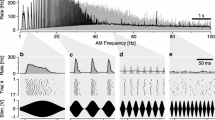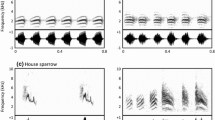Abstract
Albert Feng was a prominent comparative neurophysiologist whose research provided numerous contributions towards understanding how the spectral and temporal characteristics of vocalizations underlie sound communication in frogs and bats. The present study is dedicated to Al’s memory and compares the spectral and temporal representations of stochastic, complex sounds which underlie the perception of pitch strength in humans and chinchillas. Specifically, the pitch strengths of these stochastic sounds differ between humans and chinchillas, suggesting that humans and chinchillas may be using different cues. Outputs of auditory filterbank models based on human and chinchilla cochlear tuning were examined. Excitation patterns of harmonics are enhanced in humans as compared with chinchillas. In contrast, summary correlograms are degraded in humans as compared with chinchillas. Comparing summary correlograms and excitation patterns with corresponding behavioral data on pitch strength suggests that the dominant cue for pitch strength in humans is spectral (i.e., harmonic) structure, whereas the dominant cue for chinchillas is temporal (i.e., envelope) structure. The results support arguments that the broader cochlear tuning in non-human mammals emphasizes temporal cues for pitch perception, whereas the sharper cochlear tuning in humans emphasizes spectral cues.













Similar content being viewed by others
References
Altoe A, Charaziak KK, Dewey JB, Moleti A, Sisto R, Oghalai JS, Shera CA (2021) The elusive cochlear filter: wave origin of cochlear cross-frequency masking. J Assoc Res Otolaryngol 22:623–640. https://doi.org/10.1007/s10162-021-00814-2
Bergevin C, McDermott J, Roy S, Li F, Shera C, Wang X (2011) Stimulus-frequency otoacoustic emissions as a probe of cochlear tuning in the common marmoset. Assoc Res Otolaryngol Abstr 34:371
Bergevin C, Walsh EJ, McGee JA, Shera CA (2012) Probing cochlear tuning and tonotopy in the tiger using otoacoustic emissions. J Comp Physiol A 198:617–624. https://doi.org/10.1007/s00359-012-0734-1
Boersma P, Weenink D. (n.d.). Praat (version 6.0.20). Amsterdam, the Netherlands: phonetic sciences, University of Amsterdam. http://www.fon.hum.uva.nl/praat/
Bohne BA, Kenworthy A, Carr CD (1982) Density of myelinated nerve fibers in the chinchilla cochlea. J Acoust Soc Am 72:102–107. https://doi.org/10.1121/1.387994
Braga J et al (2015) Disproportionate cochlear length in genus Homo shows a high phylogenetic signal during apes’ hearing evolution. PLoS ONE 10:e0127780. https://doi.org/10.1371/journal.pone.0127780
Bregman AS (1990) Auditory scene analysis: the perceptual organization of sound. MIT Press, Cambridge. https://doi.org/10.7551/mitpress/1486.001.0001
Carney LH (2018) Supra-threshold hearing and fluctuation profiles: implications for sensorineural and hidden hearing loss. J Assoc Res Otolaryngol 19:331–352. https://doi.org/10.1007/s10162-018-0669-5
Carney LH, Li T, McDonough JM (2015) Speech coding in the brain: representation of vowel formants by midbrain neurons tuned to sound fluctuations. eNeuro 2:e000415. https://doi.org/10.1523/ENEURO.0004-15.2015
Coleman MN, Boyer DM (2012) Inner ear evolution in primates through the cenozoic: implications for the evolution of hearing. Anat Rec 295:615–631. https://doi.org/10.1002/ar.22422
Conde-Valverde M et al (2019) The cochlea of the Sima de los Huesos hominins (Sierra de Atapuerca, Spain): new insights into cochlear evolution in the genus Homo. J Hum Evol 136:02641. https://doi.org/10.1016/j.jhevol.2019.102641
Condon CJ, White KR, Feng AS (1994) Processing of amplitude-modulated signals that mimic echoes from fluttering targets in the inferior colliculus of the little brown bat, Myotis lucifugus. J Neurophysiol 71:768–784. https://doi.org/10.1152/jn.1994.71.2.768
Condon CJ, White KR, Feng AS (1996) Neurons with different temporal firing patterns in the inferior colliculus of the little brown bat differentially process sinusoidal amplitude-modulated signals. J Comp Physiol A 178:147–157. https://doi.org/10.1007/BF00188158
Fay RR, Popper AN (2000) Evolution of hearing in vertebrates: the inner ears and processing. Hear Res 149:1–10. https://doi.org/10.1016/S0378-5955(00)00168-4
Feng AS, Lin WY (1994) Phase-locked response characteristics of single neurons in the frog “cochlear nucleus” to steady-state and sinusoidal-amplitude-modulated tones. J Neurophysiol 72:2209–2221. https://doi.org/10.1152/jn.1994.72.5.2209
Feng AS, Ratnam R (2000) Neural basis of hearing in real-world situations. Ann Rev Psychol 51:699–725. https://doi.org/10.1146/annurev.psych.51.1.699
Feng AS, Schul J (2007) Sound processing in real-world environments. In: Narins PM, Feng AS, Fay RR, Popper AN (eds) Hearing and sound communication in amphibians. Springer handbook of auditory research. Springer, New York, pp 323–350. https://doi.org/10.1007/978-0-387-47796-1_11
Feng AS, Narins PM, Capranica RR (1975) Three populations of primary auditory fibers in the bullfrog (Rana catesbeiana): their peripheral origins and frequency sensitivities. J Comp Physiol 100:221–229. https://doi.org/10.1007/BF00614532
Feng AS, Hall JC, Siddque S (1991) Coding of temporal parameters of complex sounds by frog auditory nerve fibers. J Neurophysiol 65:424–445. https://doi.org/10.1152/jn.1991.65.3.424
Feng AS et al (2009) Systems and methods for interference suppression with directional sensing patterns. United States Patent No. US 7,577,266 B2
Fu Q-J (2008). TigerSpeech technology: innovative speech software (CIS version 1.05.02). http://www.tigerspeech.com/tst_tigercis.html/
Fulop SA (2011) Speech spectrum analysis. Springer, Berlin. https://doi.org/10.1007/978-3-642-17478-0
Fuzessery ZM, Feng AS (1982) Frequency selectivity in the anuran auditory midbrain: single unit responses to single and multiple tone stimulation. J Comp Physiol A 146:471–484. https://doi.org/10.1007/BF00609443
Fuzessery ZM, Feng AS (1983a) Frequency selectivity in the anuran medulla: excitatory and inhibitory tuning properties of single neurons in the dorsal medullary and superior olivary nuclei. J Comp Physiol A 150:107–119. https://doi.org/10.1007/BF00605294
Fuzessery ZM, Feng AS (1983b) Mating call selectivity in the thalamus and midbrain of the leopard frog (Rana p. pipiens): single and multiunit analyses. J Comp Physiol A 150:333–344. https://doi.org/10.1007/BF00605023
Galazyuk AV, Llano D, Feng AS (2000) Temporal dynamics of acoustic stimuli enhance amplitude tuning of inferior colliculus neurons. J Neurophysiol 83:128–138. https://doi.org/10.1152/jn.2000.83.1.128
Glasberg BR, Moore BCJ (1990) Derivation of auditory filter shapes from notched-noise data. Hear Res 47:103–138. https://doi.org/10.1016/0378-5955(90)90170-T
Gooler DM, Feng AS (1992) Temporal coding in the frog auditory midbrain: the influence of duration and rise-fall time on the processing of complex amplitude-modulated stimuli. J Neurophysiol 67:1–22. https://doi.org/10.1152/jn.1992.67.1.1
Gooler DM, Xu J, Feng AS (1996) Binaural inhibition is important in shaping the free-field frequency selectivity of single neurons in the inferior colliculus. J Neurophysiol 76:2580–2594. https://doi.org/10.1152/jn.1996.76.4.2580
Greenwood DD (1990) A cochlear frequency-position function for several species—29 years later. J Acoust Soc Am 87:2592–2605. https://doi.org/10.1121/1.399052
Hall JC, Feng AS (1991) Temporal processing in the dorsal medullary nucleus of the Northern leopard frog (Rana pipiens pipiens). J Neurophysiol 66:955–973. https://doi.org/10.1152/jn.1991.66.3.955
Heffner RS, Heffner HE (1991) Behavioral hearing range of the chinchilla. Hear Res 52:13–16. https://doi.org/10.1016/0378-5955(91)90183-A
Joris PX, Bergevin C, Kalluri R, McLaughlin M, Michelet P, van der Heijden M, Shera CA (2011) Frequency selectivity in Old-World monkeys corroborates sharp cochlear tuning in humans. Proc Nat Acad Sci 108:17516–17520. https://doi.org/10.1073/pnas.1105867108
Kaya EM, Elhilali M (2017) Modelling auditory attention. Philos Trans R Soc Lond B 372:20160101. https://doi.org/10.1098/rstb.2016.0101
Kemp TS (2005) The origin and evolution of mammals. Oxford University Press, Oxford
Kirk EC, Gosselin-Ildari AD (2009) Cochlear labyrinth volume and hearing abilities in primates. Anat Rec 292:765–776. https://doi.org/10.1002/ar.20907
Mehta AH, Oxenham AJ (2017) Vocoder simulations explain complex pitch perception limitations experienced by cochlear implant users. J Assoc Res Otolaryngol 18:789–802. https://doi.org/10.1007/s10162-017-0632-x
Moore BCJ, Brian R, Glasberg BR (1983) Suggested formulae for calculating auditory-filter bandwidths and excitation patterns. J Acoust Soc Am 74:750–753. https://doi.org/10.1121/1.389861
Niemiec AJ, Yost WA, Shofner WP (1992) Behavioral measures of frequency selectivity in the chinchilla. J Acoust Soc Am 92:2636–2649. https://doi.org/10.1121/1.404380
Osmanski MS, Song X, Wang X (2013) The role of harmonic resolvability in pitch perception in a vocal nonhuman primate, the common marmoset (Callithrix jacchus). J Neurosci 33:9161–9168. https://doi.org/10.1523/JNEUROSCI.0066-13.2013
Oxenham AJ, Shera CA (2003) Estimates of human cochlear tuning at low levels using forward and simultaneous masking. J Assoc Res Otolaryngol 4:541–554. https://doi.org/10.1007/s10162-002-3058-y
Oxenham AJ, Bernstein JGW, Penagos H (2004) Correct tonotopic representation is necessary for complex pitch perception. Proc Nat Acad Sci 101:1421–1425. https://doi.org/10.1073/pnas.0306958101
Oxenham AJ, Micheyl C, Keebler MV, Loper A, Santurette S (2011) Pitch perception beyond the traditional existence region of pitch. Proc Nat Acad Sci 108:7629–7634. https://doi.org/10.1073/pnas.1015291108
Rosowski JJ (2013) Comparative middle ear structure and function in vertebrates. In: Puria S, Fay R, Popper A (eds) The middle ear. Springer handbook of auditory research. Springer, New York, pp 31–65
Saddler MR, Gonzalez R, McDermott JH (2021) Deep neural network models reveal interplay of peripheral coding and stimulus statistics in pitch perception. Nat Commun 12:7278. https://doi.org/10.1038/s41467-021-27366-6
Shera CA, Charaziak KK (2019) Cochlear frequency tuning and otoacoustic emissions. Cold Spring Harb Perspect Med 9:a033498. https://doi.org/10.1101/cshperspect.a033498
Shera CA, Guinan JJ Jr, Oxenham AJ (2002) Revised estimates of human cochlear tuning from otoacoustic and behavioral measurements. Proc Nat Acad Sci 99:3318–3323. https://doi.org/10.1073/pnas.032675099
Shera CA, Guinan JJ Jr, Oxenham AJ (2010) Otoacoustic estimation of cochlear tuning: validation in the chinchilla. J Assoc Res Otolaryngol 11:343–365. https://doi.org/10.1007/s10162-010-0217-4
Shofner WP (2002) Perception of the periodicity strength of complex sounds by the chinchilla. Hear Res 173:69–81. https://doi.org/10.1016/S0378-5955(02)00612-3
Shofner WP, Campbell J (2012) Pitch strength of noise-vocoded harmonic tone complexes in normal-hearing listeners. J Acoust Soc Am 132:EL398–EL404. https://doi.org/10.1121/1.4757697
Shofner WP, Chaney M (2013) Processing pitch in a nonhuman mammal (Chinchilla laniger). J Comp Psychol 127:142–153. https://doi.org/10.1037/a0029734
Shofner WP, Selas G (2002) Pitch strength and Stevens’s power law. Percept Psychophys 64:437–450. https://doi.org/10.3758/BF03194716
Shofner WP, Whitmer WM, Yost WA (2005) Listening experience with iterated rippled noise alters the perception of ‘pitch’ strength of complex sounds in the chinchilla. J Acoust Soc Am 118:3187–3197. https://doi.org/10.1121/1.2049107
Shofner WP, Yost WA, Whitmer WM (2007) Pitch perception in chinchillas (Chinchilla laniger): stimulus generalization using rippled noise. J Comp Psychol 121:428–439. https://doi.org/10.1037/0735-7036.121.4.428
Shofner WP, Morris H, Mills M (2018) Perception of noise-vocoded tone complexes: a time domain analysis based on an auditory filterbank model. Hear Res 367:1–16. https://doi.org/10.1016/j.heares.2018.07.003
Sumner CJ, Palmer AR (2012) Auditory nerve fibre responses in the ferret. Eur J Neurosci 36:2428–2439. https://doi.org/10.1111/j.1460-9568.2012.08151.x
Sumner CJ et al (2018) Mammalian behavior and physiology converge to confirm sharper cochlear tuning in humans. Proc Nat Acad Sci 115:11322–11326. https://doi.org/10.1073/pnas.1810766115
Tan Q, Carney LH (2003) A phenomenological model for the responses of auditory-nerve fibers. II. Nonlinear tuning with a frequency glide. J Acoust Soc Am 114:2007–2020. https://doi.org/10.1121/1.1608963
Temchin AN, Rich NC, Ruggero MA (2008) Threshold tuning curves of chinchilla auditory-nerve fibers. I. Dependence on characteristic frequency and relation to the magnitudes of cochlear vibrations. J Neurophysiol 100:2889–2898. https://doi.org/10.1152/jn.90637.2008
van der Heiden M (2014) Frequency selectivity without resonance in a fluid waveguide. Proc Natl Acad Sci 111:14548–14552. https://doi.org/10.1073/pnas.1412412111
Verhulst S, Altoè A, Vasilkovc V (2018) Computational modeling of the human auditory periphery: auditory-nerve responses, evoked potentials and hearing loss. Hear Res 360:55–75. https://doi.org/10.1016/j.heares.2017.12.018
Verschooten E, Desloovere C, Joris PX (2018) High-resolution frequency tuning but not temporal coding in the human cochlea. PLoS Biol 16:e2005164. https://doi.org/10.1371/journal.pbio.2005164
Wagner JD, Gelman A, Hancock KE, Chung Y, Delgutte B (2022) Rabbits use both spectral and temporal cues to discriminate the fundamental frequency of harmonic complexes with missing fundamentals. J Neurophysiol 127:290–312. https://doi.org/10.1152/jn.00366.2021
Walker KMM, Gonzalez R, Kang JZ, McDermott JH, King AJ (2019) Across-species differences in pitch perception are consistent with differences in cochlear filtering. eLlife. https://doi.org/10.7554/eLife.41626.001
Yost WA (1991) Auditory image perception and analysis: the basis for hearing. Hear Res 56:8–18. https://doi.org/10.1016/0378-5955(91)90148-3
Yost WA (2009) Pitch perception. Atten Percept Psychophys 71:1701–1715. https://doi.org/10.3758/APP.71.8.1701
Zhang X, Heinz MG, Bruce IC, Carney LH (2001) A phenomenological model for the responses of auditory-nerve fibers: I. Nonlinear tuning with compression and suppression. J Acoust Soc Am 109:648–670. https://doi.org/10.1121/1.1336503
Zilany MSA, Bruce IC, Carney LH (2014) Updated parameters and expanded simulation options for a model of the auditory periphery. J Acoust Soc Am 135:283–286. https://doi.org/10.1121/1.4837815
Acknowledgements
Although I was not the first graduate student to join Al’s lab, I was his first graduate student from the physiology program in what was then Department of Physiology and Biophysics at the University of Illinois at Urbana-Champaign. So, it is a particular honor for me to have been invited to contribute to this special issue honoring Al, and I would like to thank Peter Narins for the invitation.
Funding
No funding was received to assist with the preparation of this manuscript or for conducting this study.
Author information
Authors and Affiliations
Corresponding author
Ethics declarations
Conflict of interest
The author has no relevant financial or non-financial interests to disclose and has no competing interests to declare that are relevant to the content of this article.
Additional information
Handling editor: Peter M. Narins
Publisher's Note
Springer Nature remains neutral with regard to jurisdictional claims in published maps and institutional affiliations.
Rights and permissions
About this article
Cite this article
Shofner, W.P. Cochlear tuning and the peripheral representation of harmonic sounds in mammals. J Comp Physiol A 209, 145–161 (2023). https://doi.org/10.1007/s00359-022-01560-3
Received:
Revised:
Accepted:
Published:
Issue Date:
DOI: https://doi.org/10.1007/s00359-022-01560-3




